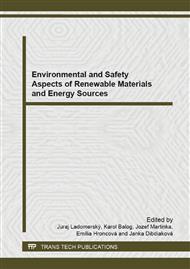p.63
p.75
p.80
p.90
p.94
p.103
p.109
p.114
p.118
Monitoring the Acid Neutralisation Capacity and Options for Leaching Iron from Waste Mud from the Production of Al2O3
Abstract:
Red and brown mud is created in the processing of bauxite into Al2O3. The chemical composition of red and brown mud depends upon the method of processing bauxite on a mud landfill, and the time and availability of mud leaching by rain. Samples of red mud from landfill in Žiarska Kotlina had pH values of 9.46 ± 0.11 and brown mud had 10.2 ± 0.15. We studied the development of changes in pH and concentrations of Fe (spectrometrically with AAS) in eluates during the leaching of red and brown mud samples. Results show that there is no release of Fe during brown mud elution. When using 0.025 and 0.05 M H2SO4 for elution, the pH decreased slightly from 10.2 ± 0.15 to 2.4 ± 0.05. Elution of 0.1 M H2SO4 shows that pH decreased to a value of 2.2 ± 0.05 by the 40th fraction and then it fell to a value of 1.77 ± 0.04 in the 100th fraction. The greatest amount of iron was released in the 8th and 55th fraction at a pH of 2 – 4 which could be observed by the change in colour of eluates. The progress of the release of iron was similar for both kinds of mud. Then we determined the neutralisation capacities of various fractions of mud in H2SO4, NaOH and H2O leachates by titration. It was discovered that the reaction of the alkaline proportions of red mud with the agent is greatest with fine granularity but for red mud, it does not change depending upon the size of the grain. The release of acid proportions depended upon time not upon texture. When leaching with water, the leached alkaline compounds from brown mud are mainly from the finest particles, and in the case of red mud, it was the opposite, from the largest particle fraction.
Info:
Periodical:
Pages:
94-102
Citation:
Online since:
August 2014
Authors:
Keywords:
Price:
Сopyright:
© 2014 Trans Tech Publications Ltd. All Rights Reserved
Share:
Citation:


